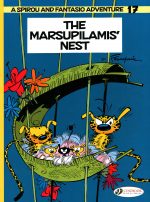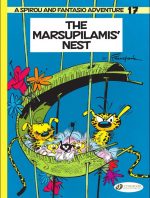


By André Franquin, translated by Jerome Saincantin (Cinebook)
ISBN: 978-1-84918-533-2 (Album PB)
Spirou (whose name translates as “squirrelâ€, “mischievous†and “lively kid†in the language of Walloons) was created by French cartoonist François Robert Velter – AKA Rob-Vel – for Belgian publisher Éditions Dupuis. The evergreen star was a response to the success of Hergé’s Tintin at rival outfit Casterman. At first, the character Spirou was a plucky bellboy/lift operator employed by the Moustique Hotel (an in-joke reference to Dupuis’ premier periodical Le Moustique) whose improbable adventures with his pet squirrel Spip evolved into astounding and often surreal comedy dramas.
The other red-headed lad debuted on April 21st 1938 in an 8-page, French-language tabloid magazine that bears his name to this day. Fronting a roster of new and licensed foreign strips – Fernand Dineur’s Les Aventures de Tif (latterly Tif et Tondu) and US newspaper imports Red Ryder, Brick Bradford and Superman – the now-legendary anthology Le Journal de Spirou grew exponentially: adding Flemish edition Robbedoes on October 27th 1938, increasing page count and adding compelling action, fantasy and comedy features until it was an unassailable, unmissable necessity for Franco-Belgian kids.
Spirou and chums spearheaded the magazine for most of its life, with many impressive creators building on Velter’s work, beginning with his wife Blanche “Davine†Dumoulin, who took over the strip when her husband enlisted in 1939. She was aided by Belgian artist Luc Lafnet until 1943, when Dupuis purchased all rights to the feature, after which comic-strip prodigy Joseph Gillain (“Jijéâ€) took over.
In 1946, Jijé‘s assistant André Franquin inherited the feature. Gradually, he retired traditional short gag-like vignettes in favour of longer adventure serials, introducing a wide and engaging cast of regulars. He ultimately devised a phenomenally popular nigh-magical animal dubbed Marsupilami, who debuted in 1952’s Spirou et les héritiers.
Jean-Claude Fournier succeeded Franquin: overhauling the feature over nine stirring serial adventures between 1969-1979 which tapped into the rebellious, relevant zeitgeist with tales of environmental concern, nuclear energy, drug cartels and repressive regimes.
By the 1980s, the series seemed stalled, with three different creative teams alternating on the serial: Raoul Cauvin & Nic Broca, Yves Chaland, and Philippe Vandevelde – writing as “Tome†– & artist Jean-Richard Geurts AKA Janry.
These last reverently referenced the still-beloved Franquin era: reviving the feature’s fortunes in 14 wonderful albums between 1984-1998. After their departure the strip diversified into parallel strands: Spirou’s Childhood/Little Spirou and guest-creator specials A Spirou Story By…
Efforts by Lewis Trondheim and the teams of Jean-Davide Morvan & Jose-Luis Munuera and Fabien Vehlmann & Yoann brought the official album count to nearly 80 (if you include specials, spin-offs series and one-shots, official and otherwise), but there are still plenty of the older vintages uncollected, just waiting for another nostalgia wave to revive them (perhaps in Complete Collections as has been done with Lucky Luke and Valerian and Laureline…?)
Cinebook have been publishing Spirou & Fantasio’s exploits since October 2009, mostly concentrating on translating Tome & Janry’s superb pastiche/homages of Franquin, but for this manic marvel (available in paperback and digitally) we hark all the way back to 1960 for pure Franquin-formulated furore and fiasco.
The contents are actual two separate yarns, originally serialised in LJdS #699-991 (1956-1957) and #1034-1045 (1958) before being collected in 1960 as 12th European album Le nid des Marsupilamis. It’s brought to you as The Marsupilamis’ Nest…
In 1952’s Spirou et les héritiers, intrepid heroes Spirou and Fantasio encountered an incredible elastic-tailed anthropoid in the jungles of Central American nation Palombia: ultimately bringing the fabulous, affable creature back to civilisation and a string of bizarre and absurd adventures.
Franquin had assumed all creative responsibilities for Dupuis’ flagship strip part-way through Spirou et la maison préfabriquée (LJdS #427, June 20th 1946). He ran wild and prospered for two decades, enlarging the scope and horizons of the stories until the feature became purely his own.
As the Bellboy became a globe-trotting journalist, fans continuously met startling new characters such as comrade/rival reporter Fantasio; crackpot inventor Count of Champignac and inept colleague Gaston Lagaffe (known in Britain as Gomer Goof). Travelling to exotic places, they uncovered crimes, challenged the fantastic unknown and clashed with nefarious arch-enemies such as Zorglub and Zantafio. They also competed with one of the first strong female characters in European comics – rival journalist Seccotine (renamed Cellophine in the current English translation).
In this compilation, the eponymous lead story sees the enquiring lads lose out on a prestigious film-&-lecture gig to Cellophine, who has truly scooped them by penetrating the Palombian rain forest to create a compelling documentary of the language, mating habits and daily life of Marsupilamis…
Dramatic, action-packed, romantic, passionate and utterly hilarious, the tale depicts the earliest moments of the manic monkey’s adorable triplets and was apparently crafted by Franquin as his wife Liliane was carrying their first child…
The joys of the wilderness are counterbalanced by an enthralling graphic essay on civilisation and human nature as La foire aux gangsters AKA ‘The Gangster Fair’ sees Spirou and Fantasio – after some spectacular initial resistance – trained in the martial arts by innocuous-seeming Yudai Nao.
The aging oriental gentleman is the dutiful bodyguard of Yankee oil tycoon John P. Nutt, whose upcoming visit to Europe has afforded gangster Lucky Caspiano a chance to extract money and exact vengeance on a despised old enemy. Our heroes’ training is intended to create unsuspected back-up for the sentinel, but when the villains brutally remove Mr Nao and kidnap Nutt’s infant son, the likely lads find themselves on their own and painfully probing a sordid street fair for clues. Eventually their investigations centre on an all-comer’s boxing booth…
Happily, the reporters have unexpected allies – such as hapless office intern Gomer Goof and a thug with a conscience – but as the caper devolves into a manic, violent chase, Spirou deduces that they have been lied to, and that not every player in this game is on the side of the angels…
The Marsupilamis’ Nest offers the kind of lightly-barbed, comedy-thriller that delights readers fed up with a marketplace far too full of adults-only carnage, testosterone-fuelled breast-beating, teen-romance monsters or sickly-sweet fantasy.
Easily accessible to readers of all ages and rendered with the beguiling style and seductively wholesome élan which makes Asterix, Lucky Luke, and Iznogoud so compelling, this is a delicious tale from a long line of superb exploits that cries out to be a household name as much as those series – and even that other kid with the white dog…
Original edition © Dupuis, 1960 by Franquin. All rights reserved. English translation 2020 © Cinebook Ltd.
